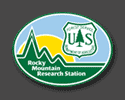|
|
PLEASE NOTE! FRAMES has a new URL: www.frames.gov Due to a reorganization of programs at USGS, after Jan. 15, 2012, old urls that contain http://frames.nbii.gov will break, so if you have bookmarked FRAMES, or shared FRAMES urls with others, please update them. We apologize for the inconvenience. FRAMES Resource Cataloging System (RCS)
The FRAMES RCS is a tool for wildland fire and other natural resource professionals to search for information about fire research and management resources, and also to catalog information about resources they have produced. The RCS currently contains more than 9,000 records from the FRAMES Resource Catalog, and also accesses an additional 26,000 resources from the Tall Timbers E.V. Komarek Fire Ecology Database. To access the RCS, look for the white Search the Resource Catalog box in the left column of most FRAMES pages. Details, Background and Future Plans: The goal of the FRAMES RCS is to be a comprehensive source of information about wildland fire-related resources, targeted to wildland fire and other natural resource professionals. It is also being designed such that those wildland fire and other natural resource professionals will be able to catalog their own resources. Currently the catalog entry interface (RCS v2) is restricted to FRAMES Staff. Partners may request access to the system and once trained, select individuals may enter and edit records in RCS v2. The RCS is organized into six resource groups: Projects, Tools (including models), Documents, Web Pages, Data, and Programs (organizations). We have also started to catalog recorded webinars, which will form the foundation of a 7th "Media" resource group that will include webinars, videos, podcasts, etc. (For now these media records are categorized under the Data resource group.) The RCS, particularly the information about documents and data, is based upon established metadata standards. Requirements for RCS Version 3.0 are being gathered. RCS v3 will include many new functions and features. For example, RCS v3 will be designed to catalog other collections beyond those of the wildland fire community. In order to accomplish this, RCS v3 will be based upon the ISO 19115-2 metadata standard. The ISO 19115-2 standard will be the foundation standard, but FRAMES will also support (input and output) other standards including the Dublin Core (web metadata standard), Darwin Core (for collections), Federal Geographic Data Committee (FGDC, a spatial metadata standard), Ecological Metadata Language (EML), Water Metadata Language (a hydrologic metadata standard), and Machine-Readable Cataloging (MARC, a bibliographic standard). Additional metadata standards are also under consideration for inclusion. A primary difference between RCS v2 and RCS v3 is that RCS v3 will be designed for researchers, so that they can create new records or edit existing records. By developing a cataloging system that integrates information about multiple types of resources (e.g., broader than just publications or datasets), we are able to provide information about relationships between resources, such as when a project produces a tool, is described by a document, and it's associated dataset, etc. Each of these records can be related to one another. There are four main components to the RCS: 1) online Resource Cataloging Tool; 2) Resource Catalog Database; 3) record display pages; 4) search/browse functionality. Information is entered into the catalog through the Resource Cataloging Tool. Information about a resource is entered through the online user interface to create a record for that resource. Controlled terms, such as Subject Areas, Geographic Areas, and Partner Sites are associated with each record, as well as other uncontrolled Key Words. And as appropriate, spatial bounding box coordinates can be entered for a record. In RCS v2, the online Resource Cataloging Tool, the Resource Catalog Database, and the record display pages are served by NACSE (Northwest Alliance for Computational Science & Engineering). Data from certain key fields in the Resource Catalog Database (a Microsoft SQL Server 2008 database) are exported nightly, in order to generate, modify or delete html pages (display records) based on cataloging activity from that previous day. Data from certain fields tagged within each record are then crawled (nightly, as well) into Vivisimo search indices developed by the USGS Core Science Systems group. These indices can then be searched through by the white "Search the Resource Catalog" box in the left column of most FRAMES pages. Plans for the near future include improving the search interface (specifically, the refinements feature), and providing an advanced search function that includes a map interface. |





